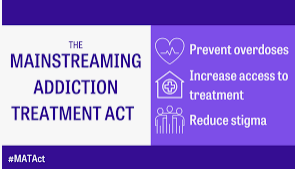TAKE 3 W/ SLP, December 2022
NOTE: Sober Linings Playbook is a personal website. Any views or opinions expressed herein belong solely to the website owner and do not represent those of individuals or organizations the owner may be associated with in a professional or personal capacity, unless explicitly stated.
“Take 3 w/SLP” is Sober Linings Playbook’s monthly summary of stories we think deserve a closer look.
One. $1.7 trillion federal omnibus spending bill includes key addiction treatment provisions
The omnibus spending bill recently passed by Congress and signed by the President included key measures targeting the opioid epidemic and addiction treatment. Chief among these are the Medication and Training Expansion (MATE) and Mainstreaming Addiction Treatment (MAT) Acts. In short, the MATE Act requires medical providers with a DEA license to prescribe controlled substances to receive education on treating patients with substance use disorders. The MAT Act will make it easier for people to access buprenorphine to treat opioid addiction by eliminating the special “X” waiver required to prescribe buprenorphine and by removing the cap that limits the number of patients to whom a provider can prescribe buprenorphine.
For more:
President Signs Bipartisan Measure to Improve Addiction Treatment, Pew Charitable Trusts, Dec. 30, 2022.
Shatterproof Applauds the Passage of the MATE Act to Expand SUD Education, Shatterproof, Dec. 23, 2022
Unpacking the omnibus’ health provisions, Politico, Dec. 21, 2022
Two. As alcohol and drug deaths among elderly increase, Medicare beneficiaries experience gaps in coverage for addiction treatment
“Rudy” was a retired fire chief I got to know when the two of us began attending a 12-step peer support group at about the same time. Rudy explained that his drinking became a problem only after he retired. With fewer obligations and more time on his hands, he filled the void with drinking and found himself starting in the morning.
Although Rudy’s late-blooming path into addiction is somewhat uncommon in peer support meetings, it is by no means unique. Consider the “carpet slippers” story in the Big Book of Alcoholics Anonymous. The story tells of a man who stopped drinking at the age of 30 because alcohol was getting in the way of his career. Upon retiring at age 55, “out came his carpet slippers and a bottle. In two months, he was in a hospital, puzzled and humiliated…Though a robust man at retirement, he went to pieces quickly and was dead within four years.”
After more than 20 years in a career with a focus on retirement policy, I have an interest in how people navigate the transition into what has traditionally been considered retirement age. Unfortunately, it seems there is a relative dearth of studies and reporting on addiction among older people. Recently, however, I was pleased to see several stories on that topic. I thought I’d share a few here.
In July, Forbes reported on a National Institute on Drug Abuse (NIDA) study that found one million adults in the U.S. ages 65 and older are living with a substance use disorder (How Older Americans Can Get Help with Addiction, Forbes, July 21, 2022). The article points to the fact that as people age, they tend to lose their identity and purpose. In addition, their bodies become more vulnerable to the negative effects of alcohol and other drugs.
In November and December, a number of stories highlighted the findings of a recent study by the National Center for Health Statistics that found deaths due to alcohol and opioids rose significantly among older Americans during the first year of the pandemic. The New York Times reported that interactions with medications along with physiological changes that occur with aging make older adults more vulnerable to alcohol and other drugs (Deaths From Substance Abuse Rose Sharply Among Older Americans in 2020, NY Times, Nov. 30, 2022).
CNBC also picked up on the National Center for Health Statistics study reporting that even though alcohol and drug related deaths are still lower among seniors, the recent increase is cause for concern (Drug overdose deaths among seniors have more than tripled in two decades, CNBC, Nov. 30, 2022). During the past two decades, drug overdose deaths more than tripled among people age 65 and older. Deaths related to alcohol among people 65 and older increased more than 18% from 2019 to 2020. The CNBC story quoted CUNY professor Alexis Kuerbis warning that “We’ve got a public health problem coming at our door – these trends have been increasing for a long time now.“
With evidence of increased struggles with alcohol and other drugs among the elderly, it’s particularly troubling to learn that gaps in Medicare coverage make it difficult for many Americans 65 and older to access treatment for substance use disorders (SUDs). A recent story in the Miami Herald reported that only about 6 percent of Medicare beneficiaries 65 or older who needed treatment for SUDs received it (Older adults face Medicare hurdles for substance use treatment Roll Call, Nov. 30, 2022)
Medicare is apparently exempt from laws that require parity between physical and behavioral health coverage. Medicare doesn’t recognize independent SUD treatment facilities as providers eligible for payment. Physicians at SUD facilities can bill for treatment, but not all programs employ doctors. Medicare doesn’t generally reimburse for services provided by licensed alcohol and drug counselors. And it doesn’t generally cover intensive outpatient treatment for SUDs.
As a result, only about 42 percent of the 16,000 SUD treatment facilities in the U.S. accept Medicare. More than 70 percent accept Medicaid, according to the Substance Abuse and Mental Health Services Administration.
We can – and should – do better for older Americans when it comes to treatment for substance use disorders.
Three. The case for safe supply
Over the past year or so, I’ve noticed quite a few media reports of deaths from toxic homemade alcohol in places like Turkey and parts of India where alcohol is highly restricted or banned outright (see for example, “37 die in Indian state due to toxic alcohol,” The Manilla Times, Dec. 18, 2022 or “At least 22 dead, 16 hospitalized from bootleg alcohol poisoning in Istanbul,” CBS, Dec. 17.)
With the days of bootleggers and bathtub gin in our distant past, stories of tainted homemade alcohol seem anachronistic in the U.S. where we regulate the manufacture, distribution, sale, and use of alcohol to ensure a safe supply and safe consumption.
But that’s alcohol.
The story is different when we consider the safety of drugs that are still illegal. We have a long way to go to ensure the safety of people who use illegal drugs. One-by-one, states are passing laws to legalize fentanyl test strips to help users test drugs for safety. But we need to think bigger. Fortunately, some are doing just that.
A recent story in the New York Times reported on the work of a University of North Carolina lab that tests samples drug users send through the mail (A High-Tech Strategy for Keeping Drug Users Safe: Analyzing their Fentanyl, New York Times, Dec. 24, 2022). The results of the work can lead to insights helpful to users, researchers and public health officials. The story reports that there are “dozens of health departments, academic laboratories or harm reduction groups using machines for drug checking around the country.
Compared to $1 fentanyl test strips, using mass spectrometers or Fourier-transform infrared spectroscopy (don’t ask me - that’s what they are using at Univ. of North Carolina) test drugs on a larger scale isn’t cheap. But the effort is supported by National Institute on Drug Abuse director Dr. Nora Volkow. The Biden administration’s 2022 national drug strategy proposes increasing drug checking services by 25 percent within three years. Let’s hope the use of high-tech testing machines takes off and becomes more widespread.
___
Here’s to a happy, healthy and productive 2023!




